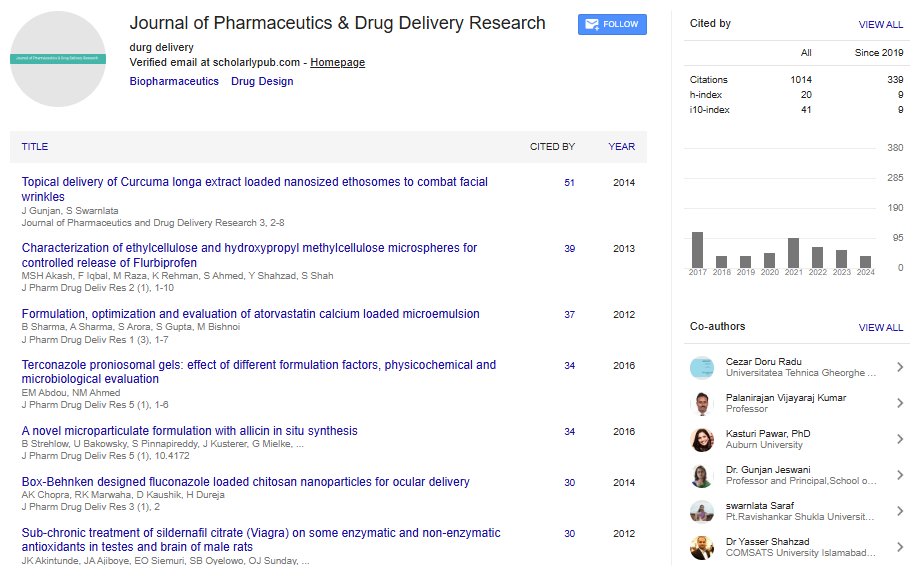Opinion Article, J Pharm Drug Deliv Res Vol: 13 Issue: 5
The Role of Drug Safety Databases in Ensuring Patient Well-being
Kewang Nan*
1Department of Toxicology and Pharmacology, Mazandaran University of Medical Sciences, Sari, Iran
*Corresponding Author: Kewang Nan,
Department of Toxicology and
Pharmacology, Mazandaran University of Medical Sciences, Sari, Iran
E-mail: nank389@gmail.com
Received date: 26 August, 2024, Manuscript No. JPDDR-24-151936;
Editor assigned date: 28 August, 2024, PreQC No. JPDDR-24-151936 (PQ);
Reviewed date: 11 September, 2024, QC No. JPDDR-24-151936;
Revised date: 18 September, 2024, Manuscript No. JPDDR-24-151936 (R);
Published date: 26 September, 2024, DOI: 10.4172/2325-9604.1000302
Citation: Nan K (2024) The Role of Drug Safety Databases in Ensuring Patient Well-being. J Pharm Drug Deliv Res 13:5.
Description
Drug safety databases play an essential role in monitoring the efficacy, safety and overall impact of medications once they are on the market. These databases serve as centralized hubs for collecting, analyzing and disseminating information on Adverse Drug Reactions (ADRs), drug interactions and other pharmacovigilance data. By doing so, they help regulatory agencies, healthcare providers and pharmaceutical companies make informed decisions that protect public health. This article discovers the structure, significance and functions of drug safety databases and how they contribute to patient safety.
Drug safety databases are complex systems designed to collect a broad range of data on drugs’ effects in real-world settings. Some of the most widely used global databases include the FDA’s Adverse Event Reporting System (FAERS), the European Medicines Agency’s EudraVigilance and the World Health Organization’s VigiBase. These databases are structured to capture.
Reports from healthcare providers, patients and pharmacists that document any negative side effects associated with a medication. Information on how drugs may interact with each other, impacting safety and efficacy. Patterns in drug usage across different demographics, including age, gender and health status. Results from clinical trials as well as post-marketing surveillance to monitor longterm effects.
The significance of these databases is immense, especially in the realm of pharmacovigilance. They provide early warning systems for identifying potentially dangerous side effects or drug interactions. For example, by analyzing trends in adverse event reports, databases can help identify previously unknown risks associated with certain drugs. This proactive approach allows regulatory bodies to take swift actions, such as issuing warnings, restricting usage, or even recalling a medication if needed.
Moreover, these databases support evidence-based medicine, allowing healthcare providers to make better treatment decisions. By having access to data on a drug’s safety profile, providers can personalize treatments based on the patient’s needs and risk factors. This data-driven approach has led to improved patient outcomes and reduced instances of severe adverse reactions.
They collect data from multiple sources, including spontaneous reports from healthcare professionals, patients and manufacturers. Advanced algorithms and statistical tools analyze data to detect signals or trends indicating possible safety issues. These databases facilitate communication among regulatory agencies, healthcare providers and the public about identified risks. Information is often shared via safety alerts, public notices and updated medication guides. Regulatory agencies rely on these databases to make informed decisions regarding drug labeling, usage restrictions, or market withdrawals.
While drug safety databases are invaluable, they are not without challenges. One major issue is underreporting. Not all adverse events are reported and some may go unrecognized by healthcare providers or patients. Additionally, there are issues related to data quality and completeness, as reports vary in detail and reliability. Furthermore, interpreting the data accurately can be complex due to impenetrable factors, such as a patient’s underlying health conditions or concurrent medications.
To moderate these challenges, many regulatory bodies are working towards creating standardized reporting guidelines and improving public awareness about the importance of reporting adverse drug reactions.
Advancements in Artificial Intelligence (AI) and Machine Learning (ML) are expected to enhance the efficiency of drug safety databases. AI algorithms can process vast amounts of data rapidly, identifying trends and patterns that might go unnoticed with traditional methods. The integration of big data from various sources, including electronic health records and social media, is also being explored as a way to improve the scope and accuracy of these databases.
In addition, there is a growing trend towards global collaboration in drug safety. Efforts are being made to harmonize data collection and reporting standards across countries, allowing for a more comprehensive understanding of drug safety on an international scale.
Conclusion
Drug safety databases are indispensable tools in the healthcare industry, providing essential data to help monitor the safety of medications after they enter the market. Despite challenges, these databases continue to evolve, adapting new technologies and methodologies to improve their effectiveness. By supporting pharmacovigilance efforts, drug safety databases not only protect patient health but also contribute to the advancement of safer, more effective pharmaceutical practices worldwide.
 Spanish
Spanish  Chinese
Chinese  Russian
Russian  German
German  French
French  Japanese
Japanese  Portuguese
Portuguese  Hindi
Hindi 
